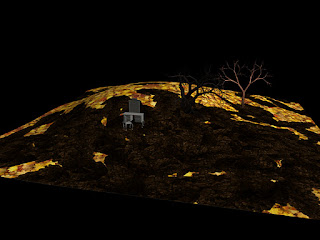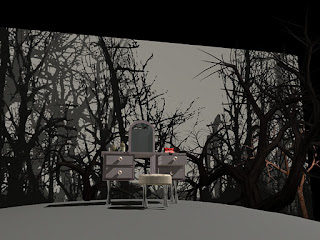I enjoyed having a few days off but was definitely ready to start unit 4!
The brown envelope gave me:
Concert Hall
Lightbulb
Juggler
Tuesday 31 January 2012
Thursday 26 January 2012
Thursday 19 January 2012
Wednesday 18 January 2012
Maya - scene lighting
Maya - accessories finished
Bottles - wireframe, UVs, textures
Hairdryer - wireframe, shaded, finished
Old paper - wireframe, UVs, shaded, finished
Tuesday 17 January 2012
Monday 16 January 2012
Photoshop, Maya, Renders and Concepts
 |
| 1) I made a leaf tile in Photoshop |
 |
| 2) leaf tile UV mapped to the ground plane |
 |
| 3) desaturated to make a bump-map |
 |
| 4) Ground plane rendered - it was too bumpy so I lessened the levels |
 |
| 5) Ground plane with test trees and furniture |
 |
| 6) Matte painting background in Photoshop |
 |
| 7) Matte Painting and Maya render |
@phil
have you got a blog address for Ollie Gadsby? The one I'm posting on doesn't seem to have been updated for ages and I know he changed his blog address at some point...thanks :)
Sunday 15 January 2012
Maya: Camera rig with thirds and diagonals
The theory of thirds is that if you place points of interest in the intersections or along the lines that your photo becomes more balanced and will enable a viewer of the image to interact with it more naturally. Studies have shown that when viewing images that people’s eyes usually go to one of the intersection points most naturally rather than the center of the shot – using the rule of thirds works with this natural way of viewing an image rather than working against it.
Diagonal lines generally work well to draw the eye of an image’s viewer through the photograph. They create points of interest as they intersect with other lines and often give images depth by suggesting perspective.
They can also add a sense of action to an image and add a dynamic looks and feel.
 |
| Picnic at Hanging Rock - thirds |
 |
| Picnic at hanging rock - diagonals |
 |
| Suspiria - thirds |
 | |||
| Suspiria - diagonals |
 |
| Blue Velvet - thirds |
 |
| Blue Velvet - Diagonals |
Subscribe to:
Posts (Atom)







































